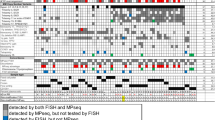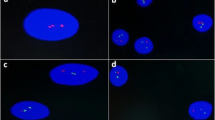Abstract
Chromosome 1q gains and 13q deletions are common cytogenetic aberrations in multiple myeloma (MM) that confer a poor prognosis. There are several techniques for the targeted study of these alterations, but interphase fluorescence in situ hybridization (FISH) is the current gold standard. The aim of the present study was to validate quantitative PCR (qPCR) as an alternative to FISH studies in CD138+-enriched plasma cells (PCs) from MM patients at diagnosis. We analyzed 1q gains and 13q deletions by qPCR in 57 and 60 MM patients, respectively. qPCR applicability was 84 and 88% for 1q and 13q, respectively. The qPCR and FISH methods had a sensitivity and specificity of 88 and 71% for 1q gains, and 79 and 100% for 13q deletions. A second qPCR assay for each region was carried out to confirm the previous results. Paired qPCR (two assays) and FISH results were available from 53 MM patients: 26 for 1q amplification and 27 for 13q deletion. qPCR assays gave concordant results (qPCR-consistent) in 20 of the 26 (77%) 1q gains and 25 of the 27 (93%) 13q deletions. Considering only the consistent data, the overall concordance among qPCR and FISH was 85 and 100% for 1q gains and 13q deletions, respectively. Our results show a substantial agreement between qPCR and the gold standard FISH technique, indicating the potential of qPCR as an alternative approach, particularly when the starting material is too scarce or cells are too damaged to obtain accurate results from FISH studies.

Similar content being viewed by others
References
Weinhold N, Kirn D, Seckinger A, Hielscher T, Granzow M, Bertsch U et al (2016) Concomitant gain of 1q21 and MYC translocation define a poor prognostic subgroup of hyperdiploid multiple myeloma. Haematologica 101(3):e116–e119
Avet-Loiseau H, Attal M, Campion L, Caillot D, Hulin C, Marit G et al (2012) Long-term analysis of the IFM 99 trials for myeloma: cytogenetic abnormalities [t(4;14), del(17p), 1q gains] play a major role in defining long-term survival. J Clin Oncol: Off J Am Soc Clin Oncol 30(16):1949–1952
Avet-Loiseau H, Attal M, Moreau P, Charbonnel C, Garban F, Hulin C et al (2007) Genetic abnormalities and survival in multiple myeloma: the experience of the Intergroupe Francophone du Myelome. Blood 109(8):3489–3495
Gutierrez NC, Castellanos MV, Martin ML, Mateos MV, Hernandez JM, Fernandez M et al (2007) Prognostic and biological implications of genetic abnormalities in multiple myeloma undergoing autologous stem cell transplantation: t(4;14) is the most relevant adverse prognostic factor, whereas RB deletion as a unique abnormality is not associated with adverse prognosis. Leukemia 21(1):143–150
Avet-Loiseau H, Soulier J, Fermand JP, Yakoub-Agha I, Attal M, Hulin C et al (2010) Impact of high-risk cytogenetics and prior therapy on outcomes in patients with advanced relapsed or refractory multiple myeloma treated with lenalidomide plus dexamethasone. Leukemia 24(3):623–628
Walker BA, Wardell CP, Melchor L, Brioli A, Johnson DC, Kaiser MF et al (2014) Intraclonal heterogeneity is a critical early event in the development of myeloma and precedes the development of clinical symptoms. Leukemia 28(2):384–390
Magrangeas F, Lode L, Wuilleme S, Minvielle S, Avet-Loiseau H (2005) Genetic heterogeneity in multiple myeloma. Leukemia 19(2):191–194
Cremer FW, Bila J, Buck I, Kartal M, Hose D, Ittrich C et al (2005) Delineation of distinct subgroups of multiple myeloma and a model for clonal evolution based on interphase cytogenetics. Genes, Chromos Cancer 44(2):194–203
An G, Li Z, Tai YT, Acharya C, Li Q, Qin X et al (2015) The impact of clone size on the prognostic value of chromosome aberrations by fluorescence in situ hybridization in multiple myeloma. Clin Cancer Res: Off J Am Assoc Cancer Res 21(9):2148–2156
Puig N, Conde I, Jimenez C, Sarasquete ME, Balanzategui A, Alcoceba M et al (2015) The predominant myeloma clone at diagnosis, CDR3 defined, is constantly detectable across all stages of disease evolution. Leukemia 29(6):1435–1437
Walker BA, Boyle EM, Wardell CP, Murison A, Begum DB, Dahir NM et al (2015) Mutational Spectrum, copy number changes, and outcome: results of a sequencing study of patients with newly diagnosed myeloma. J Clin Oncol: Off J Am Soc Clin Oncol 33(33):3911–3920
Homig-Holzel C, Savola S (2012) Multiplex ligation-dependent probe amplification (MLPA) in tumor diagnostics and prognostics. Diagnos Mol Pathol: Am J Surg Pathol, Part B 21(4):189–206
Carter NP (2007) Methods and strategies for analyzing copy number variation using DNA microarrays. Nat Genet 39(7 Suppl):S16–S21
Ceulemans S, van der Ven K, Del-Favero J (2012) Targeted screening and validation of copy number variations. Methods Mol Biol 838:311–328
D'Haene B, Vandesompele J, Hellemans J (2010) Accurate and objective copy number profiling using real-time quantitative PCR. Methods 50(4):262–270
Kumar S, Paiva B, Anderson KC, Durie B, Landgren O, Moreau P et al (2016) International Myeloma Working Group consensus criteria for response and minimal residual disease assessment in multiple myeloma. Lancet Oncol 17(8):e328–e346
Lopez-Corral L, Sarasquete ME, Bea S, Garcia-Sanz R, Mateos MV, Corchete LA et al (2012) SNP-based mapping arrays reveal high genomic complexity in monoclonal gammopathies, from MGUS to myeloma status. Leukemia 26(12):2521–2529
Garcia-Sanz R, Orfao A, Gonzalez M, Moro MJ, Hernandez JM, Ortega F et al (1995) Prognostic implications of DNA aneuploidy in 156 untreated multiple myeloma patients. Castelano-Leones (Spain) Cooperative Group for the Study of Monoclonal Gammopathies. Br J Haematol 90(1):106–112
Lopez-Corral L, Gutierrez NC, Vidriales MB, Mateos MV, Rasillo A, Garcia-Sanz R et al (2011) The progression from MGUS to smoldering myeloma and eventually to multiple myeloma involves a clonal expansion of genetically abnormal plasma cells. Clin Cancer Res: Off J Am Assoc Cancer Res 17(7):1692–1700
Ross FM, Avet-Loiseau H, Ameye G, Gutierrez NC, Liebisch P, O'Connor S et al (2012) Report from the European Myeloma Network on interphase FISH in multiple myeloma and related disorders. Haematologica 97(8):1272–1277
Mateos MV, Gutierrez NC, Martin-Ramos ML, Paiva B, Montalban MA, Oriol A et al (2011) Outcome according to cytogenetic abnormalities and DNA ploidy in myeloma patients receiving short induction with weekly bortezomib followed by maintenance. Blood 118(17):4547–4553
Dimopoulos MA, Weisel KC, Song KW, Delforge M, Karlin L, Goldschmidt H et al (2015) Cytogenetics and long-term survival of patients with refractory or relapsed and refractory multiple myeloma treated with pomalidomide and low-dose dexamethasone. Haematologica 100(10):1327–1333
Suda T, Hama T, Kondo S, Yuza Y, Yoshikawa M, Urashima M et al (2012) Copy number amplification of the PIK3CA gene is associated with poor prognosis in non-lymph node metastatic head and neck squamous cell carcinoma. BMC Cancer 12:416
Kim S, Lee J, Hong ME, Do IG, Kang SY, Ha SY et al (2014) High-throughput sequencing and copy number variation detection using formalin fixed embedded tissue in metastatic gastric cancer. PLoS One 9(11):e111693
Huang WT, Chuang SS (2013) High MET gene copy number predicted poor prognosis in primary intestinal diffuse large B-cell lymphoma. Diagn Pathol 8:16
De Preter K, Speleman F, Combaret V, Lunec J, Laureys G, Eussen BH et al (2002) Quantification of MYCN, DDX1, and NAG gene copy number in neuroblastoma using a real-time quantitative PCR assay. Modern Pathol: Off J US Can Acad Pathol, Inc 15(2):159–166
Guerrera ML TN, Xu L, Yang G, Manning RJ, Demos M, Patterson C, Castillo JJ, Dubeau T, Gustine J, Liu X, Chen J, Chen JG, Arcaini L, Varettoni M, Cazzola M, Treon SP; Hunter ZR. Chromosome 6q deletions are common in Waldenstrom’s Macroglobulinemia, and target regulatory genes for MYD88, CXCR4 and BCL2 signalling. . 9th International WOrkshop on Waldenstrom Macroglobulinemia and Symposium on advances in Multiple Myeloma Abstract Book; October 5–8 20162016
Olmedillas-Lopez S, Garcia-Arranz M, Garcia-Olmo D (2017) Current and emerging applications of droplet digital PCR in oncology. Mol Diagnos Ther
Author information
Authors and Affiliations
Contributions
MES and NCG conceived the idea and designed the study protocol; MCC, RGS, and MA carried out all the statistical analysis; AA, RM, and MHR performed the technical assistance; CJ, MIP, and MGA prepared the database and revised data congruency; MCC and MES wrote and corrected the final version of the manuscript. All authors reviewed and approved the manuscript.
Corresponding author
Ethics declarations
Funding
This work was partially supported by the Instituto de Salud Carlos III (ISCIII), Spanish Ministry of Economy and Competitiveness.
This work was partially supported by the Instituto de Salud Carlos III (ISCIII), Spanish Ministry of Economy and Competitiveness: CP13/00080, PI15/01956,CIBERONC-CB16/12/00233 and Red Temática de Investigación Cooperativa en Cáncer Asociación Española Contra el Cancer” (GCB120981SAN).
MES is supported by the Miguel Servet programme (CP13/00080) of the ISCIII (Ministerio de Economía y Competitividad). MCC is supported by the Spanish Association against Cancer.
Conflict of interest
The authors declare that they have no conflict of interest.
Rights and permissions
About this article
Cite this article
Chillón, M.C., Jiménez, C., García-Sanz, R. et al. Quantitative PCR: an alternative approach to detect common copy number alterations in multiple myeloma. Ann Hematol 96, 1699–1705 (2017). https://doi.org/10.1007/s00277-017-3083-x
Received:
Accepted:
Published:
Issue Date:
DOI: https://doi.org/10.1007/s00277-017-3083-x




